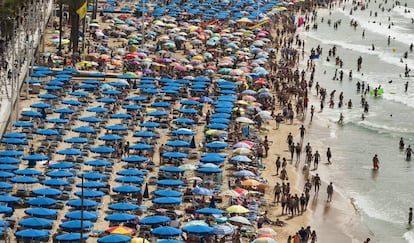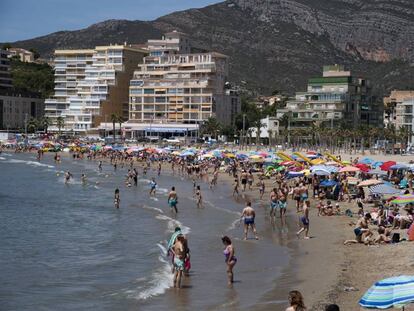Could Spain’s thriving tourism industry be coming to a standstill?
A new report has forecast a fall in visits from the country’s main tourist markets, the UK, Germany and France


In 2017, Spain received a record-breaking number of tourists with 82 million people visiting the country. Of this figure, more than half – 42 million – came from Spain’s biggest tourist markets: the United Kingdom, Germany and France.
But a new report from the Spanish Institute of Tourism (Turespaña) is predicting that these markets will experience “only moderate growth” or even a “decline or stagnation” in the third quarter, the most important of the year.
Spain must compete for distinction, quality, not for price
Exceltur vice president José Luis Zoreda
According to the Outlook Report for International Tourism published this month, tourist arrivals are expected to experience “moderate or stagnate growth,” tourist spending “moderate growth” and overnight stays a “decline or stagnation.”
The final outcome will depend on Spain’s biggest tourist markets but these have the “least promising” forecasts.
German tourists, for instance, are expected to make 5.1% fewer overnight stays, despite a 3.1% increase in arrivals and 2.4% rise in spending.
Turespaña estimates the number of British tourists will fall 4.2% in the third quarter but predicts a rise of 5.3% in tourist spending and 1.9% in overnight stays.
The outcome for France is more positive, with tourist visits expected to increase 5.7%, spending by 8.1% and overnight stays by 5%. Overall, Turespaña has forecast visitors will rise by 2.4%, spending by 5.3% and 1.1% in overnight stays.
Turespaña’s predictions, however, have missed the mark before. In July, it estimated that there would be 29.4 million overnight stays in Spain. But according to the National Institute of Statistics (INE), the figure was 28.5 million – almost a million fewer than what was forecast. This represents a fall of 11.4% from German tourists and a 2.5% drop in the British market.
The INE has not yet published its results on tourist arrivals and spending in July. But according to the report from the first quarter of 2018, German tourist visits fell by 5.1% to 5.1 million and spent €5.2 billion – a drop of 3.15% less.
In the first quarter of 2018, German tourists fell by 5.1% to 5.1 million
British tourists dropped by 2% to 8.4 million and spent €7.7 billion, a rise of 1.16%, compared to the 14.56% rise in the first half of last year.
Around 4.8 million French people visited Spain in the first quarter, indicating moderate growth of just 1.43%. Spending increased by 3.9% to €2.9 billion, which was less than half of the 8.49% growth recorded in June, 2017.
José Luis Zoreda, vice president of the tourism lobby Exceltur, blames the fall in tourist visits, particularly from the British and German markets, on the “vertiginous” recovery of the tourism industry in Turkey, which he says has been benefited from the fall in the Turkish lira. Zoreda warns against “falling into defeatism” or “getting nervous” about a possible decline in the sector and argues the industry should “not fall into the temptation” of lowering prices – a trend he has already detected in large-scale wholesalers who sell products a year ahead of time.
“Spain must compete for distinction, quality, not for price,” he said.
English version by Melissa Kitson.
Tu suscripción se está usando en otro dispositivo
¿Quieres añadir otro usuario a tu suscripción?
Si continúas leyendo en este dispositivo, no se podrá leer en el otro.
FlechaTu suscripción se está usando en otro dispositivo y solo puedes acceder a EL PAÍS desde un dispositivo a la vez.
Si quieres compartir tu cuenta, cambia tu suscripción a la modalidad Premium, así podrás añadir otro usuario. Cada uno accederá con su propia cuenta de email, lo que os permitirá personalizar vuestra experiencia en EL PAÍS.
¿Tienes una suscripción de empresa? Accede aquí para contratar más cuentas.
En el caso de no saber quién está usando tu cuenta, te recomendamos cambiar tu contraseña aquí.
Si decides continuar compartiendo tu cuenta, este mensaje se mostrará en tu dispositivo y en el de la otra persona que está usando tu cuenta de forma indefinida, afectando a tu experiencia de lectura. Puedes consultar aquí los términos y condiciones de la suscripción digital.
More information
Últimas noticias
Science seeks keys to human longevity in the genetic mixing of Brazilian supercentenarians
Luisa Neubauer, climate change activist: ‘Ecology shouldn’t be a punitive force, but a joyful and liberating one’
Trump followed CIA recommendation to hand power to Delcy Rodríguez due to risk that Machado would not control the army
The Motherwell painting that Franco wanted to hide from view
Most viewed
- Alain Aspect, Nobel laureate in physics: ‘Einstein was so smart that he would have had to recognize quantum entanglement’
- Alvin Hellerstein, a 92-year-old judge appointed by Bill Clinton, to preside over Maduro’s trial in New York
- Cuba confirms death of 32 of its citizens in the US attack against Venezuela
- Gilles Lipovetsky: ‘If you want to live better and fall in love, take Prozac, don’t look to philosophy’
- Why oil has been at the center of Venezuela-US conflicts for decades










































